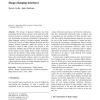Free Online Productivity Tools
i2Speak
i2Symbol
i2OCR
iTex2Img
iWeb2Print
iWeb2Shot
i2Type
iPdf2Split
iPdf2Merge
i2Bopomofo
i2Arabic
i2Style
i2Image
i2PDF
iLatex2Rtf
Sci2ools
PUC
2011
2011
Shape-changing interfaces
The design of physical interfaces has been constrained by the relative akinesis of the material world. Current advances in materials science promise to change this. In this paper, we present a foundation for the design of shape-changing surfaces in human–computer interaction. We provide a survey of shape-changing materials and their primary dynamic properties, define the concept of soft mechanics within an HCI context, and describe a soft mechanical alphabet that provides the kinetic foundation for the design of four design probes: Surflex, SpeakCup, Sprout I/O, and Shutters. These probes explore how individual soft mechanical elements can be combined to create large-scale transformable surfaces, which can alter their topology, texture, and permeability. We conclude by providing application themes for shape-changing materials in HCI and directions for future work. Keywords Form transformation Á Shape change Á Kinetic Á Morph Á Tangible interface Á Transitive materials Á Shape...
| Added | 14 May 2011 |
| Updated | 14 May 2011 |
| Type | Journal |
| Year | 2011 |
| Where | PUC |
| Authors | Marcelo Coelho, Jamie Zigelbaum |
Comments (0)

